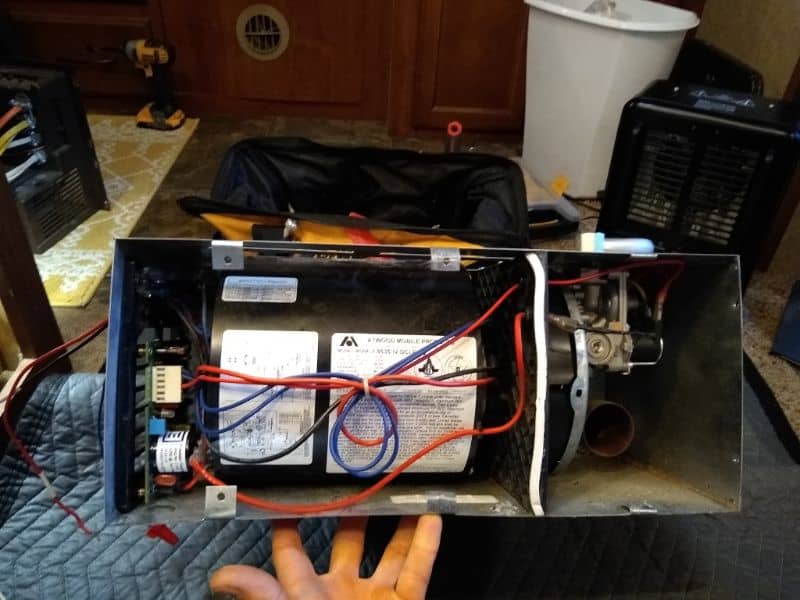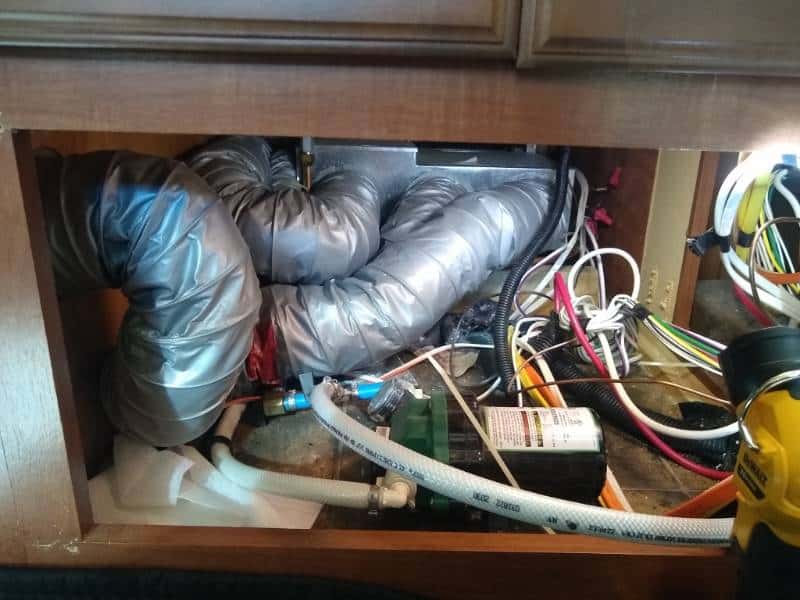RV furnace vibration is nothing to laugh at. I fixed one furnace that almost rattled the teeth out of my head. If you’re hearing vibration, buzzing, or grinding when your RV forced-air furnace is running, that should be inspected immediately.
Here are the 7 most common sources of RV furnace vibration and noise that I’ve come across. If your reason isn’t on here, let me know!
Broken/Dirty Fan Vanes

Most RV furnaces have a single motor connected to two fans, one at each end: a combustion fan and a blower fan. (These fans are often called “wheels” or “squirrel cages” for their striking resemblances). These fans can be made of metal or plastic.
The blower wheel blows air across the heat exchanger, warming the air and pumping it through the ductwork. The combustion wheel, which is much smaller, blows air through the burn chamber to mix with the propane vapor for ignition. There is no air exchange between the two sides of the system.
These fans are made up of tiny vanes. Over time, these vanes will collect dust, lint, and other debris. (In severe cases, the weight of the dust alone can cause the vibrations you’re hearing!) Also, the vanes on plastic wheels become brittle from age and heat. These vanes can snap off the wheel, which causes a weight imbalance around the rotating motor shaft. It only takes 1-2 broken vanes to significantly increase vibration and fan noise.
This is a relatively easy fix so long as you can A) access the motor and B) remove the snap ring or set screw holding the fan to the shaft. On some furnaces, just accessing these parts requires an assortment of uniquely shaped tools and curse words.
Don’t let this one go! An unbalanced motor shaft will quickly wear out its bearings, and then you’ll be spending $200 for a new motor instead of $20 for a new blower fan.
Mice or Wasps Inside the Furnace
Mice, wasps, spiders, beetles, birds, and other critters like to make their home inside your furnace during the shoulder seasons. Mice like the shape of the blower wheel; wasps and beetles seem to like the smell of the combustion side better.
When you start a furnace with a mouse nest inside the blower wheel – well, you can imagine the kind of noise and damage that would do! This will typically require new fans, and it’s smartest to replace both of them at the same time.
Many RVers prevent this infestation problem by installing mesh screens on the outside of their furnace vents. Furnace manufacturers specifically forbid this practice, arguing that any debris or snow that plugs up the mesh will impede proper airflow. They are correct – but mud daubers sure are annoying! So if you do choose to install mesh screens, check them daily while in use to make sure they are clean.
Worn Out Motor Bearings

Most RV furnaces have permanently sealed bearings. (They are usually sleeve bearings, not ball bearings.) The term “permanently sealed” is a glass-half-full kind of description. Some of them will only last a few years.
Just a few grains of sand or metal shavings can quickly scour and pit the bearing internals. At first, you’ll hear a grinding, rumbling, or screeching noise. As the damage becomes worse and the bearings get sloppy or elongated, you’ll get mechanical vibration as well.
Unfortunately, most RV furnace motors have non-serviceable bearings, so you’ll have to replace the entire motor. Lubrication is only a temporary fix. The cost of a replacement RV furnace motor generally ranges from $100 to $300.
Something’s Touching the Fan
RV furnace fans are covered by some kind of housing. In some furnaces, it’s molded plastic; in other, it’s sheet metal. If the housing is loose or bent, it could be scraping against one of the fan wheels while it’s spinning.
Also, if the fan has moved on the shaft – usually because of a broken or missing retaining ring – then it could be coming in contact with something it’s not supposed to.
It’s also possible – although not common – that one of the fans is so far off-center that it strikes the housing once per rotation. Plastic fan wheels, in particular, are known for being a bit sloppy. A new wheel will fix this problem.
Loose Furnace Mount Screws
Most RV furnaces are simply screwed to the wall or to the floor. If these screws become loose, the furnace may jostle back and forth while running. This would typically show up as a low, throbbing “hum” or “buzz” instead of a high-pitched whine.
I wish I could tell you where these mounting screws are located, but they vary so much between furnaces! Check the furnace Owner’s Manual that came with your RV. You may need to disassemble part of the furnace casing or ductwork to access the screws.
Loose Duct Work Flange

Are you sure it’s the furnace itself making the noise? If you have loose flexible duct connections to the furnace body, you might just be hearing vibrations from a loose duct flange. You can check most of these connections by hand once the furnace has cooled down. They don’t require screws; they are indented tab connections that rotate a quarter-turn to tight.
Bad Air-to-Fuel Ratio
Your RV furnace requires the proper air-to-fuel ratio to correctly and completely ignite the propane. A lean or rich mixture might show up as a “whump-whump-whump” sound while the furnace is running, when could sound like a mechanical vibration from a distance.
Describing the fix to this issue is beyond the scope of this article. The simplest thing to do is make sure your combustion system – combustion wheel, burner chamber, electrode, heat exchanger, and vents – is all clean.
Remember – Access, Access, Access!

One last word on fixing your RV furnace noise problem – access (or lack thereof). Some motors can be accessed and replaced in half an hour (usually, an exterior access door is required, like the picture shown here).
But if your furnace was installed beneath a cabinet, no access door, and flexible ducting – be prepared to spend several hours, as you’ll need to completely uninstall and reinstall the furnace. You’ll be disconnecting the gas line, too, so this might be a good time to contact your local RV service technician!
Leave a Reply